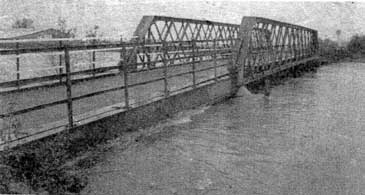The information presented is there to be used and enjoyed but please be sure to
acknowledge the source and author if you use any material.
Snippets of Yesteryear
The opening of Thorne's Jubilee Bridge

Jubilee Bridge pictured last November (2000) when the floodwaters of the Don threatened. Interestingly when the bridge was built in 1887 it was said to be 12ft above the highest flood tide.
JUBILEE Bridge was opened 103 years ago - `a very important day, not only for Thorne, but also" for Sykehouse and Fishlake' said the newspaper report of the time.
THURSDAY afternoon, December 29th, 1887, saw the completion of an undertaking which has been agitated now for sixty years. The necessity of having a bridge across the Don, somewhere in the vicinity of Thorne, which should render communication with the adjacent villages across the river more easy and convenient has at last been accomplished. The matter with the Jubilee commemoration, and Mr A L Pease at once taking up the project offered his services gratuitously.
'The bridge will not only carry you, but your children and your children’s children'
It was eventually agreed that an effort should be made to obtain funds to build a bridge, and the Jubilee Committee took the affair in hand. This committee consisted of Mr A L Pease, Mr W L Darley, Mr G Dunston Mr W M Darley, Mr O Haycroft, Mr S Duckett, Mr T E Stones, Mr G Maud, Mr T Bailey, Mr H Marsden, Mr Lynas, Mr Wood, Mr J Acaster and Mr W Armitage. It was eventually decided that Fratson's Ferry would be the most convenient place to build the bridge, and subsequently Mr Radcliffe, of Sheffield was consulted as to building it. In the meantime a subscription list had been opened, and amongst the principal donors were the Jubilee Committee, £10; the Manchester, Sheffield, and Lincolnshire and North Eastern Railway Committees each, £50; Mr A L Pease (in addition to his services), Mr G Dunston and Mr Lynas £10 each Mr Marsden, £100; the Badsworth Hunt, £75; and others.
FRATSON'S FERRY
The bridge was erected at Fratson's Ferry, about one mile from Thorne; and through' its erection there is a communication made with the Sykehouse Road and the Sour Sluice. or in other words, between Thorne, Sykehouse, and Fishlake. The bridge which is of iron, is 90 feet between cylinder and cylinder, with 20 feet on either side. It rests on two buttresses at each side, is equal to carry 10 tons, and is 12 felt wide. The main girders are of lattice type, and are 8 feet deep. The bridge is built 12 feet above the highest flood tide. The work has been carried out, under Mr Pease, by Mr Radcliffe of Sheffield, and is admitted on all hands the latter has well discharged his duties.
Yesterday afternoon, at three o'clock, a procession was formed in the 'Market Place, Thorne, and from thence proceeded to the bridge. On arriving here, Mr Pease, those present might consider it very important day – not only for Thorne, but for Sykehouse and Fishlake.
He hoped the bridge would prove all the service that it was intended. He wished success to the bridge, and hoped it might not only be found convenient, but would add to the prosperity of Thorne and the adjoining places it led to. As they called it Jubilee Bridge, they would conclude by singing "God Save the Queen".
Mr G Dunston thought it would be unfair to disperse without thanking Mr Pease. He (Mr Dunston) had taken part in the Jubilee proceedings, but these would not have come to much without the perseverance and energy of Mr Pease. Mr Pease had devoted much of his time to this one object an object, he believed,' which would prove advantageous both for Thorne and the neighbouring villages. He called three cheers for Mr Pease. Someone in the crowd called for cheers for Mrs Pease.
Mr Pease, in responding, expressed his thanks, but asked for cheers for the man who had built the bridge, as he had done it at the lowest possible cost.
Mr Radcliffe, in replying, said that he had tried to give a sovereign for a sovereign. He believed the bridge would not only carry them, but their children and their children’s children. He thanked them heartily for giving cheers.
The party then dispersed.
In the evening, there was a dinner at the Pease Hall, in honour of the event. Mr Pease presided, and Mr C Haycroft occupied the vice-chair.
Thanks to Glyn Ambrose Thorne and District Gazette
for permission to use this information.
© Thorne Moorends Regeneration Partnership. All Rights Reserved.
